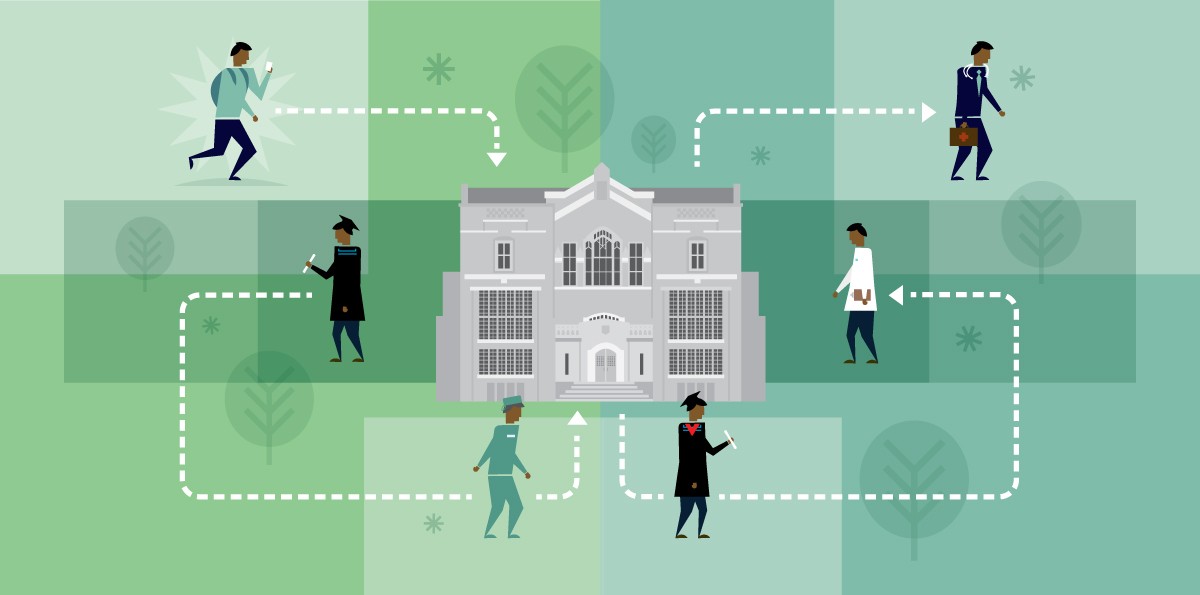When asked to talk about open badges, I always need to answer the very basic question: what is an open badge? You’ve probably earned a badge at some point in your life. Think back to your childhood and Boy Scouts or Girl Guides, where physical badges were earned for specific accomplishments like woodworking or volunteering. More recent examples of badge earning can be found in video games and in social applications, like FourSquare or Untapped, where digital badges are issued for specific milestones or achievements. But what makes open badges different from badge earning in these spaces is their association with developing informal learning records and sharing the evidence of learning activity in open environments.
Open badges are digital symbols that signify evidence of an accomplishment, skill, quality or participation in an experience. Similar to learning portfolios that provide a more in-depth view of an individuals’ ability, badges can provide proof of ability through metadata. The badge image has “baked-in” metadata that outlines the criteria and evidence required to earn the badge. The benefit of badges for the earner is the ability to share and showcase them across social networks. Mozilla has created a standard that allows badges from a variety of platforms to be stored in a single location called a “backpack.” The “backpack” holds your earned badges, providing a profiled space for all your badge activity. This space also allows the earner to organize collections and share them on a variety of sites, such as LinkedIn, Facebook, Twitter, and WordPress.
While issuing badge credentials for activities and skills isn’t a new idea, they are a relatively new application in education. While badging is emerging in large numbers in the non-profit and K-12 environments, projects in academic environments are much smaller in number and research on open badges in these environments is in its infancy. However, there is a great deal of excitement about their potential. Badge integration with the co-curricular record could support tracking, authenticating student engagement, and highlighting skills and qualities important both inside and outside educational environments. Furthermore, badges support personal ownership over learning data. Formal learning credentials, like transcripts or diplomas, are held by the institution attended. With open badges, the story of a learners’ skills, abilities and knowledge can be managed and expressed by the earner through the evidence of the badges and through the collection of badges made publicly viewable (Bull, 2014) (Presant, 2014).
While many conversations around open badges in academia highlight the potential for co-curricular records, skills-based credentials, and personalized learning data, the impact they may have on the formal academic learning ecosystem is difficult to determine. Badges are at the innovation stage, where badge projects are emerging but their success remains undefined and unproven. What badges will mean for university environments will require not only a larger number of implementations and assessment of outcomes, but also a clear idea of what badges mean in the academic environment and how they are governed. With the UBC Open Badges pilots, questions about governance, new forms of credentialing and authority are fast becoming issues that need to be addressed.
The Open Badges UBC pilot project for the 2014-2015 year focused on testing badging across three unique environments: Digital Tattoo, ETEC565M-Mobile & Open Education, and Law 423B-Video Game Law. The purpose of the pilot was to use badges to complement the learning environment by recognizing achievement, engagement and knowledge acquired during the course of the program. While the first year of the pilot focused on the implementation of badging in the specific courses/programs, questions around governance and the development of an institutional badging framework is a central concern moving into the second year of the project. In an environment that includes extracurricular, co-curricular, and curricular learning opportunities, badging can be implemented in a variety of spaces, by a variety of issuers, and with variable criteria and evidence. Answering the question of what environment badges can be issued in, who can implement badges, and the type of evidence needed for the badge to be issued is necessary before we can answer what badges will mean in an academic (i.e. UBC) setting.
The potential for badging to greatly impact recognition and credentialing is dependent on how the program is defined and structured. Development of a large and diverse badging ecosystem is the key to building unique badge pathways across issuing organizations. The ability to connect badges across departments and from a variety of badge issuers to develop impactful learning stories for earners is one of many desired outcomes of badging programs. However, the potential to create rigid decisions on what can and cannot be badged potentially limits this possible outcome. For the badging program to grow at UBC, decisions about badging the full spectrum of education activity from courses, co-curricular programs, professional development, and continuing studies needs to occur. While badging co-curricular, extra-curricular and professional development is simplest as they are not necessarily connected to an official credit, integrating badging into programs that provide some element of certification is far more complex. To what degree can a badge be integrated into a course or program that carries a credit? Can course assessment be badge-based? And if so, what percentage of the course can be badge-based assessment? (Knight et.al., 2014)
The benefit of open badges is not just in the earning and sharing but also in issuing. Issuers of badges can create learning opportunities on topics and areas in which they have knowledge, skill, and ability without the formal sanctioning of an institution. The potential for badges to be developed, issued, and endorsed by a larger population is possible and in many ways preferable as it speaks to the broader spectrum of learning and engagement across campuses and communities. For example, badge issuing by student organizations for involvement in student governance could highlight skillsets acquired that currently are unrecognized. The challenges of quality and authority in supporting all badge issuers from staff to students to external collaborators are a concern in building a badging framework.
There are a number of debates around imposing quality control practices and authority on what essentially is a response to informal learning recognition. As open badges are adopted into the academic environment, the potential to exclude badge issuers that are not a part of the formal education system becomes a real possibility (Ravet, 2015). Assigning a grade for course work, and the final course credential, is within the authority of the instructor, while informal learning opportunities, like extracurricular learning through workshops, are offered from non-credential giving units (e.g. UBC Library.) If badging becomes a part of the credentialing landscape, how does this impact issuers and the issuing body? Additionally, with the potential of partnerships and endorsement of badges from external parties, the issuing of a credential (i.e. a badge) would no longer be fully in the hands of the academy. What responsibility is there for non-UBC members in endorsing a badge to evaluate the work of the badge earner?
Adding to the complexity of governance and badge frameworks is the very association of the badges with UBC. Currently the open badges project has not sought to be more fully branded as a UBC project. There are no badges that are currently offered with the UBC colours, symbols, or logos. While this seems inconsequential, institutional endorsement of badges through branding could further develop a market for badge earning and issuing. The use of institutional branding could strengthen the badge credibility and value outside of the institution, thereby increasing the worth of the badge for earners (Hickey, 2014). However, if the badges are now offered with the UBC brand, what responsibility is there to ensure the badges meet particular criteria so as to maintain the perceived value of UBC as a brand in itself? Who makes the decisions that a badge is qualified to be associated with UBC, and does that decision only include the formal authority, that of an instructor, who can grade and give credit?
While these questions fall under the broader topic of governance of the badging program, addressing them speaks to the very real potential for badges to be disruptive to the formal education process. Any new form of credentials, especially those that could be applied across informal and formal environments, issued by instructors, staff, and students, and bears the authority of UBC as an academic institution, could cause a shift in how the final degree is issued and exhibited to the world. What if a transcript had a list of issued badges curated by the earner? The transcript would potentially become a more accurate record of learner activity but would also need to be open to the learner to curate, an interesting but complex idea in an environment where the student record is rigidly managed and issued.
While the Open Badges UBC project continues to test badging applications in a variety of environments, decisions on what a badge from UBC means will need to be discussed, debated and developed into a framework that balances the issues raised here and many more that could arise in the coming year.

Erin Fields is a Liaison Librarian and Flexible Learning Coordinator for the UBC Library. She is also lead of the Open Badges UBC project.

Its like you read my mind! You appear to know so much abut this, like you wrote the book inn it or something.
I think tuat yyou can do with some pics to drive the message home a bit, but instad of that, this is great blog.
An excellent read. I will certainly bbe back.